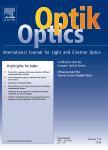版权所有:内蒙古大学图书馆 技术提供:维普资讯• 智图
内蒙古自治区呼和浩特市赛罕区大学西街235号 邮编: 010021

作者机构:Department of Electrical and Computer Engineering University of Mohaghegh Ardabili Ardabil Iran
出 版 物:《Optik》 (Optik)
年 卷 期:2025年第322卷
核心收录:
学科分类:0710[理学-生物学] 070207[理学-光学] 1001[医学-基础医学(可授医学、理学学位)] 07[理学] 08[工学] 100102[医学-免疫学] 0803[工学-光学工程] 0702[理学-物理学]
主 题:Urology
摘 要:This study presents a three-band absorbent structure based on cut graphene, which has been used as a biosensor for the detection of prostate-specific antigen (PSA) due to the tunability of the resonance frequency of graphene and the polarization-independent capability of the proposed structure. The sensor is composed of three layers: a copper substrate with a conductivity of 5.831 ×107, a silicon dioxide (SiO₂) dielectric layer with a permittivity of 3.9, and a graphene layer with strategic cuts to enhance absorption. The performance of the proposed structure was evaluated by measuring its absorption at three terahertz frequency bands: 3.9 THz, 8.52 THz, and 11.83 THz, achieving absorption values of 99.65 %, 99.25 %, and 99.78 %, respectively. These high absorption rates make the sensor an excellent candidate for biosensing applications, particularly for detecting PSA in clinical samples. By testing the sensor with analytes containing PSA at 100, 200, 300, and 400 PM concentrations, the refractive index values were 1.3477, 1.3654, 1.3831, and 1.4008, respectively. When the analyte layer is placed on the three-band absorber structure, the peak shift is absorbed, enabling the detection of the desired analyte. The proposed structure demonstrated remarkable sensitivity, achieving 2638.4 GHz/RIU at a refractive index of 1.3831 and a frequency of 11.451 THz. This high sensitivity is particularly advantageous for detecting low concentrations of analytes. Such a sensor has great potential for enhancing the detection of biomarkers. These findings highlight the sensor s potential for high-sensitivity PSA detection, offering a valuable tool for early prostate cancer diagnosis and screening. © 2025 Elsevier GmbH